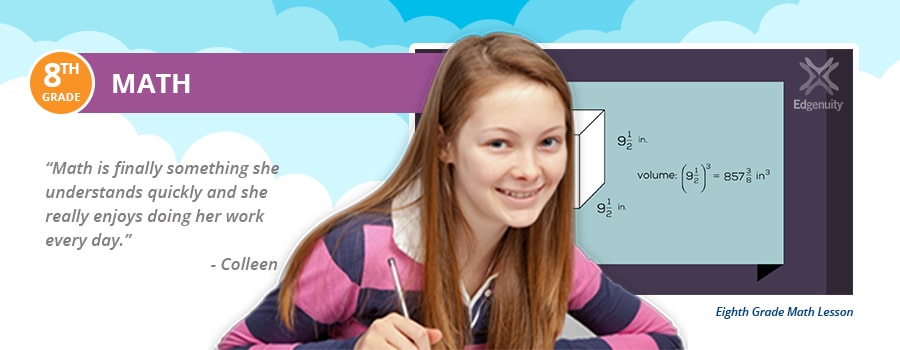Eighth Grade Math Curriculum and Lesson Plans
Eighth-grade math is typically a course in pre-algebra to help prepare students for high school algebra. Our 8th-grade math curriculum can be used either as a main homeschool program or as a supplement to another homeschool curriculum or a traditional school. The following information will explain what steps you should take to meet your child’s 8th-grade math goals and objectives and how our 8th-grade math curriculum can help.
What Math Should an 8th Grader Already Know?
An 8th-grade math program should cover various areas of mathematics, not just arithmetic. The primary strands for an 8th-grade math curriculum are number sense and operations, algebra, geometry, and spatial sense, measurement, and data analysis and probability. While these math strands might surprise you, they are all critical lessons for an 8th-grade math curriculum.
These skills will improve math fluency and help build upon the math facts, concepts, and strategies acquired in the past, making future success more achievable. Here are some topics that eighth graders should already know in math:
- Writing numbers in word, standard, expanded, and scientific notation
- Identifying and using ratios and rates
- Multiplying and dividing with positive and negative rational numbers
- Finding the perimeter and area of two-dimensional figures
- Identifying and plotting ordered pairs in four quadrants and along the axes
- Calculating probabilities of independent and dependent events
If your student needs to review 7th-grade math concepts, you can easily access those lessons thanks to our flexible grade-level options that give you access to one level above and one below your child’s default grade.
Eighth-Grade Math Objectives
The following is a general list of some math learning objectives eighth graders should attain:
Identify rational and irrational numbers and describe meanings.
Calculate and approximate principal square roots.
Identify and perform transformations of a figure on a coordinate plane.
Solve problems in two variables using linear equations.
Define and differentiate between different types of sampling techniques.
Use technology to determine the mean, median, mode, and range of a set of real-world data.
Eighth-Grade Math Scope & Sequence
Express numbers between zero and one in scientific notation.
Identify rational and irrational numbers and describe meanings.
Identify and explain absolute value.
Compare large numbers in scientific notation.
Compare small numbers in scientific notation.
Add and subtract numbers in scientific notation.
Use scientific notation with technology
Convert repeating decimals to fractions.
Calculate and approximate principal square roots.
Use roots to solve equations.
Compare and order numbers in many forms including: fractions, decimals, scientific notation, absolute value, and radicals.
Use estimation for situations using real numbers.
Apply properties to solve problems with real numbers.
Simplify numerical expressions with real numbers.
Use divisibility rules to solve problems.
Represent numbers in base ten in other bases (two, five, and eight) and vice versa.
Identify numbers as relatively prime.
Describe and use rate of change to solve problems.
Use proportional relationships to find measures of length, weight or mass, and capacity or volume.
Solve real world problems involving percents greater than 100.
Compare two proportional relationships.
Solve real world problems with rational numbers (including integers, decimals and fractions).
Solve real world problems with ratios, rates, proportions, and percents.
Solve real world two- or three- step problems with integers, decimals, fractions, ratios, rates, proportions, and percents.
Substitute rational numbers into expressions and evaluate.
Substitute rational numbers into expressions with exponents and radicals.
Translate word expressions and equations into algebraic expressions and equations (including one or more variables and exponents).
Translate verbal expressions and sentences into algebraic inequalities and vice versa.
Use variables to represent unknown quantities in real world situations.
Combine and simplify algebraic expressions with a maximum of two variables.
Evaluate algebraic expressions and equations by substituting integral values for variables and simplifying.
Solve linear inequalities in one variable algebraically.
Identify the number of solutions in a linear equation.
Solve equations with variables on both sides.
Solve equations requiring the distributive property.
Solve equations requiring combining like terms.
Analyze systems of equations.
Identify the number of solutions in a linear equation.
Use properties of parallelism, perpendicularity, and symmetry to solve real world problems.
Compare and describe properties of convex and concave polygons.
Apply the Pythagorean theorem to solve real world problems.
Identify congruence and similarity in real world situations and justify.
Identify and perform transformations (reflection, translation, rotation, and dilation) of a figure on a coordinate plane.
Identify how changes in dimensions affect area and perimeter.
Transform lines and line segments.
Transform parallel lines.
Use a sequence of transformations.
Understand similar figures.
Describe sequences of transformations that show similarity.
Prove triangle theorems informally.
Understand angles formed when parallel lines are cut by a transversal.
Explore angle-angle similarity.
Use the converse of the Pythagorean theorem.
Apply the Pythagorean theorem in three dimensions.
Apply the Pythagorean theorem in the coordinate plane.
Find the volume of pyramids, prisms, and cones.
Find the surface area of pyramids, prisms, and cones.
Compare regular and irregular polygons.
Find the angle measure in two-dimensional figures and two-dimensional sides of three-dimensional figures based on geometric relationships.
Identify the relationship between volume or surface area and dimension.
Interpret and apply various scales including number lines, graphs, models, and maps.
Select tools to measure quantities and dimensions to a specified degree of accuracy and determine the greatest possible error of measurement.
Identify the number of significant digits as related to the least precise unit of measure and apply to real world contexts.
Use a table to find ordered pair solutions of a linear equation in slope-intercept form.
Graph linear equations in standard form.
Identify and graph inequalities on a number line.
Identify and graph inequalities in the coordinate plane.
Solve problems in two variables using linear inequalities.
Given the graph of a linear relationship, determine the x- and y- intercepts.
Given the graph of a line, determine the slope.
Given the slope and y-intercept, write an equation.
Find a function rule to describe a linear relationship using tables of related input-output variables.
Using information from a table, graph, or rule, determine if a function is linear and justify.
Graph proportional relationships and interpreting slope.
Use similar triangles to understand slope.
Use slope-intercept form.
Interpret y = mx + b as a linear function.
Compare functions represented in different forms.
Interpret y = mx + b as a linear function.
Construct linear functions.
Describe a functional relationship by analyzing a graph.
Sketch graphs of functions.
Calculate conditional probabilities and the probabilities of dependent events.
Define and differentiate between different types of sampling techniques.
Use different types of sampling techniques to collect data.
Identify whether a sample is biased.
Interpret circle, line, bar, histogram, stem-and-leaf, and box-and-whisker graphs including how different displays lead to different interpretations.
Identify and explain how statistics and graphs can be used in misleading ways.
Determine appropriate measures of central tendency for a given situation or set of data.
Use technology to determine the mean, median, mode, and range of a set of real world data.
Why Choose Time4Learning Eighth-Grade Math Homeschool Curriculum
Our 8th-grade online math curriculum can be used as a main homeschool program or to supplement other curricula or school. Time4Learning’s adaptable program allows students to work across grade levels. For example, if your student is “at-level” in language arts but ahead in math, they could use the eighth-grade language arts curriculum and the suggested 9th-grade math curriculum.
If your eighth grader is struggling to prepare for high school math, Time4Learning’s curriculum can be used as a supplement to get back on track. You can use our eighth-grade math lesson plans to locate specific topics that your student needs to review. Additionally, our automated grading and recordkeeping system saves you time and helps you easily keep track of your child’s progress.







